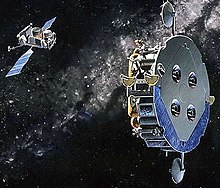
The Orbital Maneuvering Vehicle (OMV) was a project developed by NASA in the 1980s, aiming to create a reusable, remotely controlled, free-flying vehicle capable of performing various on-orbit missions and services to support orbiting spacecraft.[1][2][3][4][5][6]
Originally envisioned as a short-range robotic space tug for moving payloads in the vicinity of the Space Shuttle and Space Station,[7][8][6] the OMV was part of NASA's 1984 Space Station Freedom plan, and was initially estimated at $400 million.[1]
In 1984, NASA awarded three $1-million study contracts to Vought, Martin Marietta, and TRW.[1][9] TRW secured the $205-million OMV phase B contract in June 1986.[2] However, estimated costs had risen to $465 million by 1987, leading to the cancellation of further work on the project.[1]
- ^ a b c d "OMV". www.astronautix.com. Retrieved 2024-01-25.
- ^ a b Huber, William G. (1988-01-01). "Orbital maneuvering vehicle: A new capability". Acta Astronautica. 18: 13–23. Bibcode:1988AcAau..18...13H. doi:10.1016/0094-5765(88)90081-1. ISSN 0094-5765.
- ^ Huber, William; Cramblit, David (1984-04-01). "Orbital Maneuvering Vehicle (OMV) Missions Applications and Systems Requirements". Space Congress Proceedings. Bibcode:1984nos..proc....7H.
- ^ Arcilesi, Charles J.; Holliman, Charles T. (1988-10-01). "The Orbital Maneuvering Vehicle - A new capability". Bangalore International Astronautical Federation Congress. Bibcode:1988bang.iafcR....A.
- ^ "NASA's New Launch Systems May Include the Return of the Space Tug". SpaceRef. August 7, 2005. Archived from the original on February 2, 2013. Retrieved July 25, 2014.
- ^ a b Portree, David S. F. (December 2013). "Linking Space Station & Mars". WIRED. Archived from the original on May 18, 2023. Retrieved July 25, 2014.
- ^ Huber, W. G.; Cramblit, D. C. (1984-01-01). "Orbital Maneuvering Vehicle (OMV) missions applications and systems requirements". New Opportunities in Space. Bibcode:1984nos..proc....7H.
- ^ "NASA's New Launch Systems May Include the Return of the Space Tug". SpaceRef. August 7, 2005. Archived from the original on February 2, 2013. Retrieved July 25, 2014.
- ^ Department of Defense appropriations for 1986, pt. 1, p. 242.